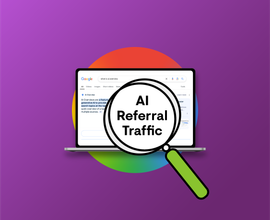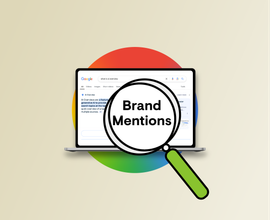The Importance of Finding and Fixing your Broken Links
As the internet evolves and sites change and migrate, users will inevitably navigate to broken links. Instead of getting the content or answers they need, users see an error message and no clear path forward, AKA a bad user experience.
Google wants to promote helpful content, and links to broken pages aren’t helpful. In fact, they make for higher bounce rates, fewer conversions, and worse rankings. Finding and fixing broken links within your content is critical for your site’s health, user experience, and SEO strategy.
What are broken links?
Broken links refer to webpages that don’t load properly or provide the result a user was expecting when navigating there. This manifests most often as a 404 error page, explaining that the page you’re looking for doesn’t exist. Maybe it was moved, maybe it was deleted. All the user knows is that the information they’re looking for isn’t there.
It’s important to keep in mind the difference between broken internal linksInternal links
Hyperlinks that link to subpages within a domain are described as "internal links". With internal links the linking power of the homepage can be better distributed across directories. Also, search engines and users can find content more easily.
Learn more, broken external links, and broken backlinksBacklinks
Backlinks are links from outside domains that point to pages on your domain; essentially linking back from their domain to yours.
Learn more:
- Broken internal links are links within your content that direct users to another piece of content on your site.
- Broken external links refer to links within your content that direct to a piece of content on a different site.
- Broken backlinks refer to a link within a piece of content on another site that links to your content.
Despite their differences, each one is critical to pay attention to as it relates to SEO and user experienceUser Experience
User experience (or UX for short) is a term used to describe the experience a user has with a product.
Learn more (UX).
Examples of broken links
Not all broken links mean the same thing. Some broken links come from human error, like typos within a link, while other links break down over time in a phenomenon called link rot .
- Page not found: AKA a 404 error. This error message means that the page or content you’re looking for does not exist on the server.
- Bad request: AKA a 400 error. This means that the host server cannot understand the URL in question.
- Bad host: This means that the server with that name doesn’t exist or is unreachable because of an invalid hostname.
- Bad URL: Refers to a URL with errors or typos in it—for example, a URL with extra slashes, missing hyphens, wrong protocols, etc.
- Bad code: AKA Bad system configuration, this refers to an invalid HTTP response code.
- Internal server error: AKA 500 error. This is essentially a catchall for unexpected issues that don’t fit into one of these other categories.
- No content: AKA a 204 error. The URL returns an “empty” page with no content.
- Reset: This happens when the host is consistently unable to connect to the server because it’s too busy or misconfigured.
- Timeout: HTTP requests constantly timed out during the link check.
Why do links break?
While there’s no default, one-size-fits-all reason why links break, there are some common reasons to look out for. The most common reasons for links breaking include:
- Incorrect links: These refer to links that are broken because of a mistake in the URL. This tends to be caused by human error and can often manifest itself in the bad URL example above.
- Content being removed: This can affect your links to internal pages, downloadable content, and external pages. Regardless of which it is, the link breaks because the piece of content or page you are linking to has been removed or unpublished from the larger site. If you are intentionally removing content from your site, keep track of the pages that link to this content and remove the links, or employ a permanent redirect to a similar page to avoid confusion and a poor user experience.
- Website migrations: A super common reason for link breaking happens when migrating content to another site or CMS. Website migrations are massive undertakings, especially for large sites with a lot of content, so it’s easy for broken links to slip through the cracks. Errors stemming from migrations could include linking to staging environments instead of completed pages, links to an incorrect or outdated domain, or links to relative URLs rather than absolute URLs.
- Link rot: Like rot in nature, this refers to decay, and as the internet continues to evolve, links will naturally begin to break down over time. If left unchecked for too long, you may be faced with multiple links that have decayed and broken altogether, simply caused by the passage of time.
Why are broken links bad?
Regardless of what caused your links to break or which error code your users receive, broken links are bad news. There are two ways to look at broken links and their effect on your website: from a UX perspective and an SEO perspective.
Why broken links are bad for users?
Imagine for a moment that you’re searching for a product on Google; you click on a link and receive an error page rather than the product you were looking for. If it’s a site you trust, you may be able to forgive one broken linkBroken Link
A broken link is a link that has no object or does not lead to anything.
Learn more here and there, but after multiple broken links, UX breaks down, and the website loses an opportunity to convert when you bounce to a different page. Maybe you’ll even buy from a competitor instead.
All this is to say, at what point would you become frustrated as a user and stop using the site altogether? That’s the same thought your users have each time they navigate to a broken link, which often leads to an increased bounce rate for the linked page.
Why broken links are bad for SEO?
In short, broken links are bad for SEO because they make for a poor UX. Google’s goal when surfacing content on SERPs is to provide users with the best content and most helpful experience. Therefore, Google is not going to direct users to a site that has multiple broken links instead of the helpful content users need.
In addition, Google’s process of finding and indexing new content relies heavily on links, as Google uses links to crawl from one page to another. If your site has a broken link, that’s a whole page that Google won’t be able to crawl, index, and surface in the SERP. A broken link would also stop Google from crawling other parts of your site that the broken page is linking to. If your pages can’t be crawled, they can’t rank and can’t drive organic traffic.
How do I find broken links?
Obviously, you can’t allow broken links to remain on your site; you need to fix them before too many users are affected by the issue and your rankingsRankings
Rankings in SEO refers to a website’s position in the search engine results page.
Learn more suffer. Depending on the size of your site, you could comb through all of your content and manually test the links, but that’s not feasible for most companies. To find broken links without allocating too many resources and time, it helps to have a platform like ContentKing.
ContentKing is the only tool that monitors your site and pages 24/7 and immediately alerts you of any issues that arise so you can take action before your rankings are impacted. ContentKing also tracks and logs all of the changes made to your site so that you can pinpoint when and where URL issues arise. These features help to take the guesswork out of identifying broken links, allowing you to resolve the issues quickly.
In addition, Google Search ConsoleGoogle Search Console
The Google Search Console is a free web analysis tool offered by Google.
Learn more can be an asset in helping to identify internal broken links. GSC will notify you of any page errors it encounters when crawling your site. You can find these errors by navigating to Google Search Console, clicking on the Crawl tab, and selecting the Crawl Errors tab. Google Search Console will also prioritize the errors it finds based on pages receiving the most traffic so you can focus first on pages that actually drive traffic.
How do I fix broken links?
Fixing broken links depends on what is wrong with the link. For example, if a link is broken and directs users to a 404 page because of typos in the URL, you can easily fix the issue by inputting the correct URL. Unfortunately, fixing broken links isn’t always that easy. Below, we’ll dive into some specific ways to resolve issues around broken links.
How to fix broken internal links
- Fix errors and typos in URLs: As mentioned above, sometimes the issue is a simple typo. Make sure to review a page’s URL before publishing and double-check URLs when linking between pages to avoid mistakes.
- Republish or recreate the content on a broken page: If a page was unpublished or you no longer have access to the content, you can recreate and republish the content on another page. This is where the Wayback Machine can come in handy to access content that no longer appears on your site.
- Redirect to another page: Sometimes, you have multiple pages that cover similar topics. In some cases, this can lead to keyword cannibalization, so you may be better off having one article covering the topic. A broken page will still lead to a poor UX, so we recommend redirecting to a similar page so you can still provide users with the information they need.
- Remove the broken link: The broken link may direct users to content that has been removed for being outdated, unhelpful, or irrelevant. You can simply delete the link from your content.
- Leave as a 404: Not all pages should be redirected. If a page does not generate any relevant traffic or have any backlinks, you should leave it as a 404 In this case, you should delete the broken link so users aren’t directed to an error page.
- Deindex from Google: AKA a 410 status code. You would use a 410 if you have removed a piece of content that previously existed and you want to permanently remove it from Google.
How to fix broken external links
Because these links don’t point to your own content, your options for fixing these are a bit more limited.
- Remove the broken link: An obvious but imperfect fix; you would just remove the broken link and not link to anything. That said, you most likely had the initial link to provide some much-needed context to a topic, so removing a link entirely may make your content less helpful and impactful.
- Update or replace the broken link: The original link may be broken because the article has been moved to a different URL. You could do a site search of the domain in Google to try and find the updated URL for the article and update the broken link. You can also just find a different source that covers the same topic and link to that instead.
How to fix broken backlinks
If an external source is linking to a piece of content on your site, that is great for your SEO because other sites and Google see your content as a trusted and authoritative source on a topic, so broken backlinks that point to error pages are serious issues for your traffic and rankings potential. To fix broken backlinks, you can:
- Republish the content: Sometimes a link breaks because a page is removed or unpublished by mistake. If this is the case, simply republish the content, and it will reclaim its lost equity.
- Redirect to a related page: Just like how you may fix a broken internal link, if you have a very similar page, you can 301 redirect to that page. Be wary of this, though; if the pages are not closely related, Google may treat it as a soft 404.
- Contact the owner of the linking site: You may have moved the content to a different URL but still want to accrue link equity from the content’s backlinks. In this case, you can try reaching out to the owner of the site linking to your content and ask them to update the link to the correct URL.
How do I prioritize fixing broken links?
Not all broken links are created equal. Broken links on some pages are relatively harmless, while broken links on others can be catastrophic. Which pages to prioritize comes down to a few key metrics that should surface during your routine content audit. Essentially, you want to prioritize fixing links to pages that impact your business the most. Some core components to keep in mind when prioritizing which broken links to fix include:
- How much relevant organic traffic each page drives
- Each page’s rankings
- Whether a page has a downloadable asset that drives conversions
- The quality of the content on the pages
Essentially if you rely on a page to drive organic traffic, conversions, or ROI, then prioritize fixing links to or from these pages first. You should still fix broken links to pages that drive less traffic, but it’s less of a priority because the impact will be felt by fewer users.
How to monitor your site for broken links
Finding and fixing broken links is all well and good, but it’s only a one-time interim solution or band-aid if you don’t have a scaleable plan in place to monitor your site for broken links proactively. Again, you can do this manually, but in order to scale this process to secure your traffic, rankings, and page performance, it helps to invest in a platform like ContentKing. ContentKing’s 24/7 site monitoring feature takes care of this for you, keeping track of everything that happens on your site in real-time and sending prioritized alerts to your inbox if pages become non-indexable, links suddenly break, or a page gets deleted.
FAQs
Should I treat broken images like broken links?
- Yes. Broken images are the same as broken links because the result is the same for the user. If a user clicks on an image and it brings them to an error page, that provides a poor UX, just like it would be with a broken text link. Poor UX makes for poor SEO every time. The good news is that ContentKing also monitors images and alerts you of any issues.
How do I open a broken link?
- You may need to access content from a broken link later on to improve an existing piece or to create something new. Just because something is delivering an error message doesn’t mean the content doesn’t have value. There could be a lot of useful information in content with broken links. You can use The Wayback Machine to access content you can’t find on Google anymore.
What is broken link building/hijacking?
- Broken link building refers to the process of finding a broken link to a piece of content, then contacting the owner of the linking article, and asking them to link to a piece of your content instead of the broken link to create a valuable backlink. This process could be very impactful for your SEO, but be wary of how some may try to take advantage of this to try and link to unhelpful, spammy, or even scam websites.
Broken links in review
Ultimately, broken links, whether the result of human error or just the natural decay of the internet, are bad news for your users and SEO strategy. If not properly fixed and monitored, broken links can cause your traffic, authority, and rankings to tumble while your number of frustrated users and bounce rate increase. To get the most out of your SEO strategy and offer the best experience possible to your users. You need to know how to find and fix broken links consistently.







